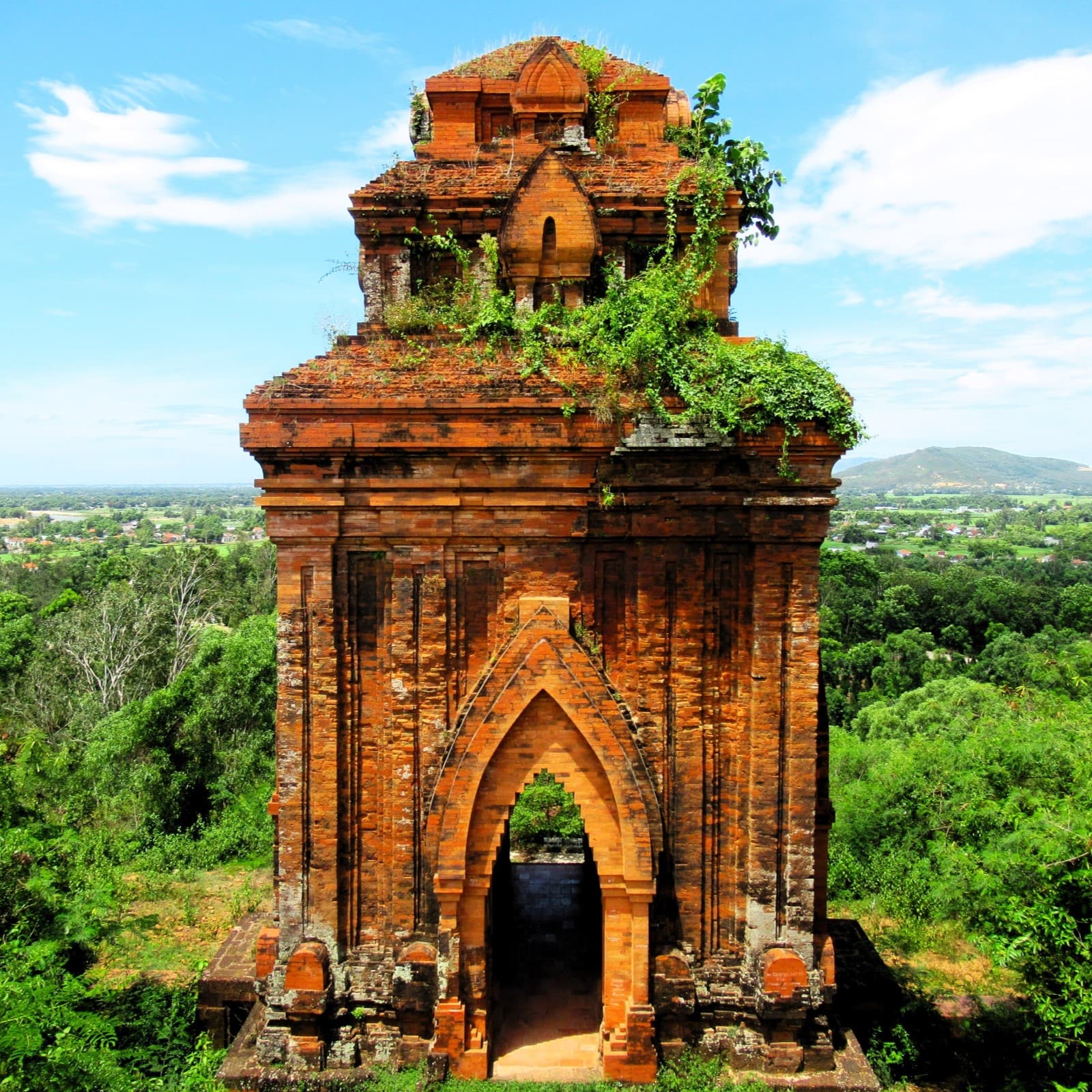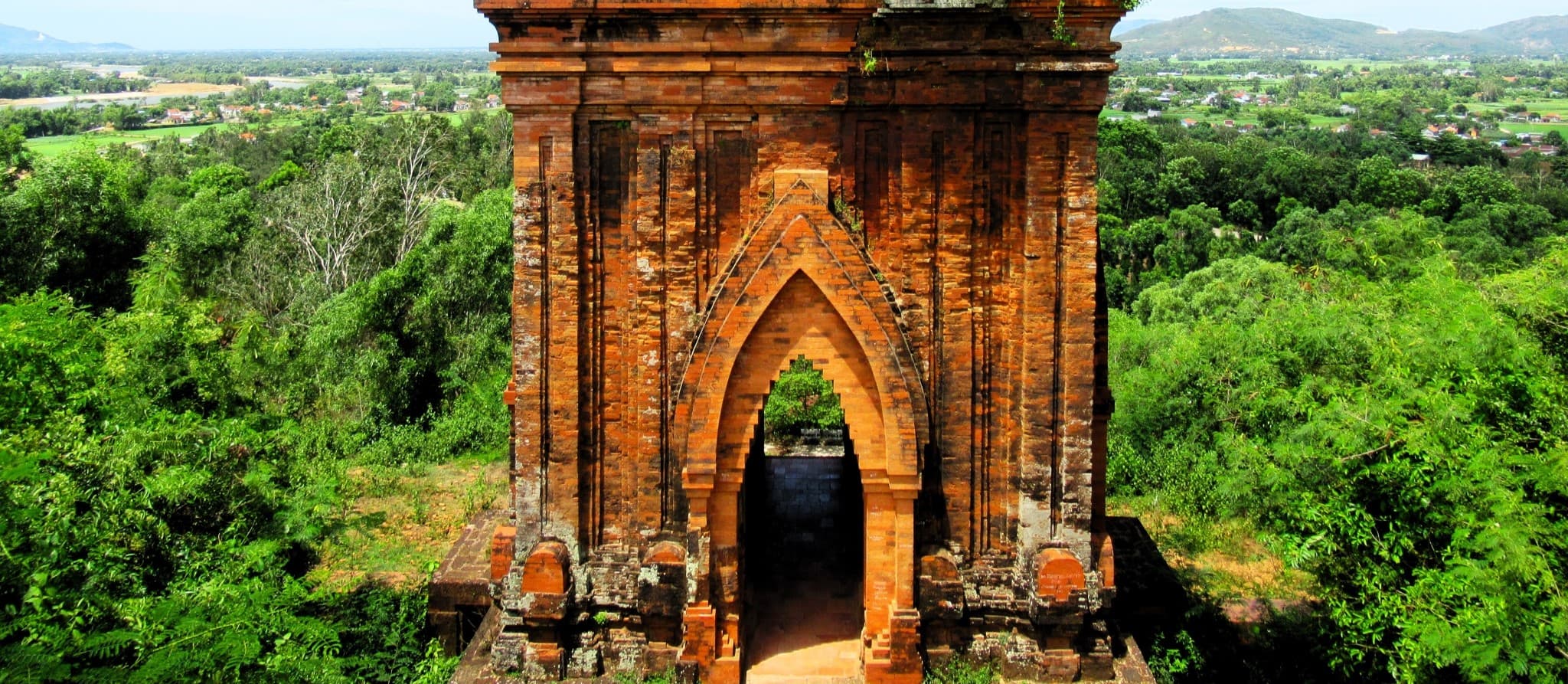Last updated April 2024 | Words and photos by Vietnam Coracle | 16 comments

Tom Divers is the founder and creator of Vietnam Coracle. He’s lived, travelled and worked in Vietnam since 2005. Born in London, he travelled from an early age, visiting over 40 countries (he first visited Vietnam in 1999). Now, whenever he has the opportunity to make a trip, he rarely looks beyond Vietnam’s borders and his trusty motorbike, Stavros. Read more about Tom on the About Page, Vietnam Times and ASE Podcast.
Scattered across the central coast and plains of Vietnam are the ruins of the ancient kingdom of Champa. Lasting for over a thousand years from the early centuries of the first millennium CE, Cham civilization thrived in the lush, fertile valleys and sheltered bays of Central Vietnam. Vijaya, near present-day Quy Nhơn in Bình Định Province, served as the Cham capital for 500 years from the late 10th century until 1471, when it was finally taken by the Vietnamese from the north. An Indianized culture whose religion for most of its existence was Hinduism, the ruins of Cham towers, temples, shrines and cities are a powerful reminder of the rich history of what is now Vietnam. Visiting the impressive Cham towers and bare remains of Vijaya city makes a very rewarding daytrip from Quy Nhơn and a welcome cultural add-on to the region’s coastal attractions. In many ways, seeing the remnants of Cham civilization in this region is far more affecting than visiting the more famous ruins of Mỹ Sơn, near Hội An. While the latter receives many thousands of visitors, the sites near Quy Nhơn are serene and seldom seen. There’s more of a sense of history here than most other historical sites in Vietnam (or in Europe for that matter).

[Back Top]

9 CHAM TEMPLES, QUY NHON
Impressive yet Rarely Visited Ruins of the Ancient Kingdom of Champa
In this guide, I’ve focused on nine Cham sites within easy reach of Quy Nhơn, in Bình Định Province: all but one (Hòn Chuông tower) can be visited in a single day on a sort of ‘Cham loop’. The best way to travel between the ruins is by motorbike (or bicycle, if you factor in a lot more time) or a taxi or hired car arranged through your hotel. (Public transportation isn’t really an option if you want to visit all nine locations.) I’ve marked the nine sites on my map and written a brief introduction to each one, including a bit of historical context and several photos. The sites are all well-maintained and entrance fees are minimal or free. If, like me, you have a general interest in history and enjoy wandering through deserted ruins of lost civilizations, then you’ll love these Cham sites. Some of the temples are so impressive that it’s difficult to understand why they aren’t more famous and more popular. It’s also worth dropping by the Quy Nhơn Museum for some historical background. (For more guides to historical sites, see Related Guides.)
CONTENTS:
Cánh Tiên Tower & Vijaya Citadel
*Please Note: Historical information in this article is based only on my limited reading & understanding of various sources & conversations with people: I am not an historian & I cannot vouch for the accuracy of historical details in this article.

MAP:
9 Cham Temples near Quy Nhơn
Dương Long & Thủ Thiện Towers
[View Map]
Featuring triple towers, Dương Long is one of the most impressive archaeological sites in Vietnam, and yet hardly anyone visits it. The three towers stand in a row, with the two shorter ones flanking the central tower which, at 39m, is the tallest surviving Cham structure in Vietnam. The red brick towers are on a colossal scale and several giant stone lintels remain in place above the entrances, as do some decorative sculptures on the sides of the towers. As with most of the sites in the region, the Dương Long temple complex is about 900 years old, dating from the 12th century. As well as being one of the most striking Cham sites in the nation, the fact that few people visit makes it feel as though you’ve stumbled upon these ancient ruins in the Central Vietnamese landscape for the first time. There’s a small ticket kiosk and a large exhibition building that has already fallen into disrepair with mold on the walls and plants growing up its walls. But surely it won’t be long before these triple towers start to draw many more visitors. It certainly has a lot of potential.
Across the river south of Dương Long is the 11th century Cham tower of Thủ Thiện. Standing all alone on the river plain, until 1985 this tower was apparently overgrown by a large banyan tree, whose roots enveloped the top of the ancient monument. Locals were too superstitious to attempt to disentangle the tree and the monument, but one day a violent storm passed through and blew the banyan tree over without damaging the tower.





Bánh Ít Towers
[View Map]
Hiding in plain sight just 15km northwest of Quy Nhơn, Bánh Ít towers are seldom visited despite being easily accessible and in full view of National Highway 1A. Beautifully restored, the four Cham towers at Bánh Ít have a powerful presence and a commanding position atop a hill. Although the site is fully developed to accommodate many hundreds of visitors, tourist numbers are few and if you visit at lunchtime you could have the site to yourself. Down the centuries, the Cham Kingdom was pushed further and further south due to Chinese and Vietnamese military advancement from the north and attacks from the Khmer Angkor kingdom from the west. Thus, the Cham towers in Bình Định Province are later than those in Quảng Nam Province to the north, such as Mỹ Sơn. The four Cham towers at Bánh Ít date from the 12th to 13th centuries, when the Cham capital had shifted south to Vijaya after the fall of Indrapura, near present-day Đà Nẵng. The Bánh Ít towers are wonderfully situated on a breezy hilltop with panoramic views over the cultivated flood plains of the Thị Nại River, with the Trường Sơn Mountains to the west and the ocean to the east.
As is often the case with ‘holy lands’, this location has continued to be sacred for future inhabitants, long after the Cham (and the Hindu deities whom they worshiped) had declined. A Buddhist monastery stands at the foot of the hill and a cemetery is scattered over the lower slopes. As with sacred sites across the Mediterranean, it would seem that land, once sanctified, remains holy through the centuries, regardless of what religion is currently dominant in the area. A well-maintained pathway leads up and around the temple complex and it’s possible to enter the towers themselves. Unfortunately, someone at the provincial tourism authority thought it would be a good idea to pump loud music through speakers throughout the site.






Cánh Tiên Tower & Vijaya Citadel
[View Map]
Vijaya (also known as Chà Bàn and Đồ Bàn) is one of those places with a lot of history but very little visible signs of it. The Cham capital from the 11th to 15th century, Vijaya was rich and prosperous. As such, it was subject to many besiegements, sackings and bloody battles. The Khmer, Mongol and Vietnamese armies all came and conquered, but, as far as I understand, the citadel stood in one form or another, albeit by different names and under the control of different dynasties, until at least the early 19th century. The site of Vijaya was in Vietnamese hands since 1471, when it was finally captured by emperor Lê Thánh Tông, who oversaw the battle in which some 60,000 Cham were killed. Then, during the Tây Sơn Rebellion, which overthrew the ruling Vietnamese imperial dynasty in the late 18th century, Vijaya was rebuilt as Hoàng Đế Citadel, stronghold of the Tây Sơn Dynasty in Central Vietnam. However, this only lasted a generation, as Hoàng Đế was ultimately taken, retaken, and taken again after several more brutal sieges by Nguyễn Ánh, who would later become emperor Gia Long, the first of the Nguyễn Dynasty emperors.

Very little remains of the once great citadel. Parts of the original city wall stand, but most of it has been restored. Open excavations reveal some of the original Cham structure, but the majority of what you see today dates from the Nguyễn Dynasty, from the 19th century. Still, it’s an atmospheric place to visit and there’s no one else around. I find there’s a certain pathos about Vijaya today: for all of the blood that was spilled in order to hold it or defeat it, all the importance and significance it once had, it’s now hardly more than a forgotten field amongst farmland, with the Reunification Express train rattling by several times a day, a few airplanes passing overhead on their descent to Phú Cát Airport, cows munching grass next to stone dragons, and farmers pedaling silently past. This is the site of some momentous shifts in the history of the land we now know as Vietnam, yet it attracts very little interest.
Only a couple of minutes due east of Vijaya, Cánh Tiên tower stands on a gentle rise that was once part of the ancient citadel. Heavily restored, many of the tower’s decorative features appear to be representations of the tropical foliage that dominates lowland Vietnam. As such, (and as with all Cham towers in Vietnam) the architecture fits its natural environment, managing to be both dominant and harmonious at the same time. Cánh Tiên tower was constructed in the 12th century.




Phú Lốc & Hòn Chuông Towers
[View Map]
Very rarely visited but, in many ways, one of the most exciting towers, Phú Lốc is a gigantic castle-like structure built at the top of a small hill. A narrow paved lane branches due east off Highway 1, winding through an increasingly medieval-feeling rural area. When I visited, I stopped to ask directions from a clutch of bare-chested sinewy octogenarian men gathered in the shade of an ancient tamarind tree marking the site of an 18th century event during the Tây Sơn Rebellion. They pointed me down ever narrower lanes, passing haystacks drying in the sun and tethered oxen munching lethargically. I kept glimpsing the hilltop ruins through the foliage, but it always seemed to disappear again. The lane turned to dirt and led through a village cemetery beneath whispering eucalyptus trees at the foot of a hill. After dismounting my bike and walking along a steep, tight trail where arid bushes scratched my bare arms, I arrived at a grassy clearing. Battered stone steps led up to Phú Lốc tower, standing resolutely on the hilltop as if it were a part of the natural landscape, unmoved by time. In the clearing, the tower cast a welcome shadow in which to sit and admire the view down over the plain, with the ancient capital of Vijaya and Cánh Tiên tower clearly visible to the south. The tower itself is big and time-worn. Partially restored, it’s lost none of its gravitas. Goats and cows roam beneath the tower and, sadly, there’s a lot of trash. Phú Lốc is apparently influenced by Khmer architecture, as the two kingdoms were constantly at war during the early 12th century, when the tower was constructed.
Only known to historians in the region since 1993, Hòn Chuông is a 12-metre-high Cham tower consisting of red bricks on top of a huge granite boulder marking the peak of a mountain in the Núi Bà Range, some 20km north of Quy Nhơn. Completely isolated and hidden from view, the tower is also cut off because there is no way up the boulder to reach it. In order to visit the site, it’s necessary to hike up the mountain and then climb the boulder. This remarkable tower still remains a mystery.


Tháp Đôi & Bình Lâm Towers
[View Map]
Located just 5 minutes northwest of downtown Quy Nhơn, these two towers are situated in a pleasant park next to a busy road. The juxtaposition of the ornate ruins, dating from the 12th-13th century, and the honking traffic passing by is a little jarring. The towers’ arching forms and floral motifs are echoed, to some extent, in the crowns of the long and slender coconut palms and other tropical trees that grow around them. Inside, the towers taper upwards for 20 metres, like giant red brick chimneys, before opening to the sky. It’s unusual for Cham temple sites to have just two towers – normally, there are three – and the assumption is that the third tower was planned but never constructed due to an unknown event or circumstance. Owing to its easy access, Tháp Đôi (Twin Towers) is by far the most visited of the Cham temple sites in Quy Nhơn and the surrounding region. In particular, it’s a popular selfie spot for Vietnamese teens. Early morning is the best time to visit.
A little further north of Quy Nhơn city, Bình Lâm is probably the earliest of the towers in this guide, dating from the late 10th to early 11th century. Bình Lâm once stood within a citadel that was capital of Champa before it moved further inland to Vijaya. The large, solitary tower is notable as it stands at street level, rather than on a rise or hill.



*Disclosure: I never receive payment for anything I write: my content is always free and independent. I’ve written this guide because I want to: I like these Cham towers and I want my readers to know about them. For more details, see my Disclosure & Disclaimer statements and my About Page



The 9 chăm temples, which I visited in the low season, all temples with gates except the one in Quy Nhon city were closed. It was a nice trip through the countryside, but who’s really interested to see them should maybe book a guided tour which makes sure the entrances are staffed, otherwise it might end up being a disappointment.
Hi Michael,
That’s interesting – I’ve never experienced closed gates before at any of these temples. Perhaps it’s because it was low season or maybe some of the temples have specific opening times now. It would be helpful if you could let me know which specific temples were closed and what time of day you visited. For example, it’s common for some sites to close during lunch hours – usually 11am-2pm.
Best,
Tom
Dear Tom,
Thank you very much for your website. I would be grateful if you could help me with some queries.
I’m lucky that I have been to Vietnam a few times and I have already been to a few of the known sites, so I’m intrigued by Quy Nhon. I’m going to South Vietnam for a wedding in December and although the season is not ideal around the central coast, I have never been to Quy Nhon/ Nha Trang so I thought I would be braving the weather and go there for general hanging out and some sightseeing, following the train line. I’m too scared and clumsy to drive a motorbike, so I was wondering if I was to hire a car driver, how long roughly would it take me to cover the 8 Cham temples ( I was hoping to combine this with a ride to the station or with another local site) ?
My other question is regarding the weather: i understand the chances of rain are high, but I live in the UK and I wildswim in The Thames when it is 20 degrees, so did you mean the weather would be worse than this or just bad in comparison with a tropical climate?
Thanks for your help
Hi Thanh Mai,
Regarding the weather – it can be wet and cool at that time of year, but it is nothing like the UK.
For driving, unless you have a Vietnamese license, you won’t be able to hire a car to self-drive. You can either hire a car and driver (try asking at your hotel) or you can get a taxi for the day.
You could cover all the temples in this guide in one day, but of course it depends on how long you want to stay at each site.
Best,
Tom
Hi Tom. I just came to Quy Nhon. Iam from Indonesia. How can I get your book about 50 temples Khmer in Delta Mekong Province?
Hi Seno,
It’s not a book, it’s an article: you can read it on this page.
Best,
Tom
Hi Tom
I hope you are well. I recently received a newsletter from you, the main picture was of a beautiful horseshoe shaped bay.
It was south of Hot An. I can’t find the email anywhere, is it possible to send me a link to it please.
It would have been sent in the last week or so.
I hope everything is going well for you.
Best
Gav
Hi Gav,
Are you sure it was an email? I haven’t sent an email newsletter about a beach in the last few weeks. Perhaps it was a social media post? Do you follow Vietnam Coracle on any of my social media channels?
Best,
Tom
Hi Tom,
yes I do, I’ll check them out. Thank you for taking the time to let me know.
Best
Gavan
Thanks for info. I am also intrested in Cham and Khmer remains in Vietnam. From my personal research, some Vietnamese temple is actually Khmer temple before. I found remains such as Linga and Yoni but now completely looks like Vietnamese temple. Thai and Laos preserves those Khmer remains since their cultures are similar from India but in Vietnam, the culture is from China and they normally break Khmer related things completely and keeps statues in museum and tends to build their temple at same place. So, it is seriously difficult to find remains. Especially, when i travel to Mekhong delta, the area has same culture as Isaan in Thailand and Cambodia. So, it used to be one country. People personality are similar too. It is quite interesting.
Hi Ken,
Yes, it’s very interesting. Actually, I’m just about to publish a guide to over 50 Khmer temples in the Mekong Delta Province of Tra Vinh. It will be available later this week on my site or you can sign up on my Subscriber Page if you want to get an email notification when I publish it.
Best,
Tom
Thanks for the info. i visited all the temples except for Thu Thien. I went twice all the way down 19 b across the river and into the neighborhoods on the other side of highway 19 and never found it. Two days looking for it. But thanks for a wonderful site, well composed. Lonely Planet was worthless. I am still im Vietnam waiting for the virus problem to pass and want to try again.
Hi Daniel,
I’m glad you saw the towers. If you go back, you should be able to find the Thu Thien towers fairly easily – the location is even marked on Google Maps.
Good luck,
Tom
Sorry, Tom, this is the correct link:
https://www.youtube.com/watch?v=c0iCnAMiJ0g
Hi Lan,
Thank you for sharing that – it’s a very sad song, but beautiful lyrics.
Tom
These are valuable information. There’s a song called Hận Ðồ Bàn written by a Vietnamese song writer, Xuân Tiên, dedicated to the lost Kingdom of Champa. Such a beautiful yet sad song. This video was recorded in 1994.
https://www.youtube.com/watch?list=RDc0iCnAMiJ0g&v=uYaDNle4X0A